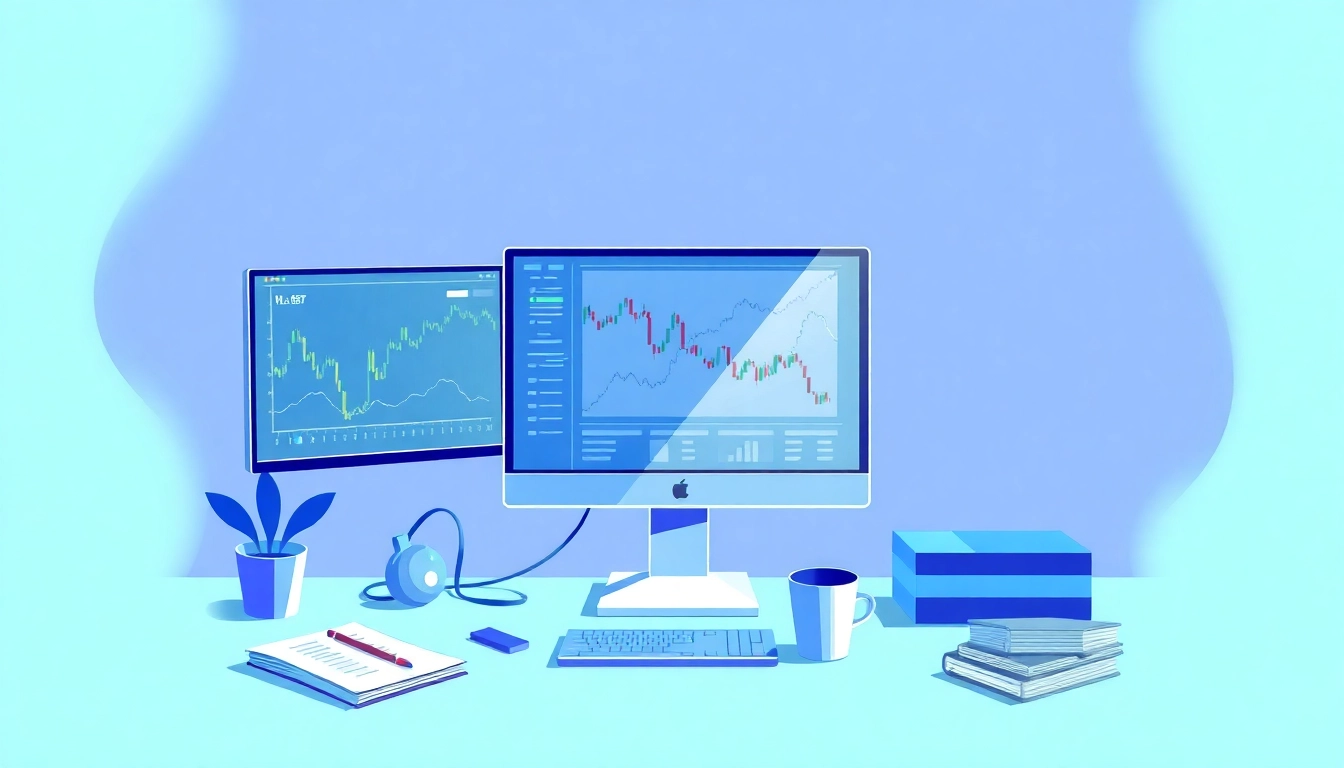Understanding Trading Tools
In the fast-paced world of trading, whether in stocks, forex, or cryptocurrencies, the right set of trading tools can be the differentiator between profit and loss. The array of trading tools available can empower traders by providing necessary insights and analysis, thereby enhancing decision-making. Understanding these tools is crucial, especially for those embarking on their trading journey.
What Are Trading Tools?
Trading tools encompass a broad spectrum of software applications, platforms, and resources designed to aid traders in executing their strategies effectively. This includes charting software, trading platforms, analytical tools, and market news aggregators. They help in real-time market analysis, backtesting strategies, managing risks, and tracking performance, making them indispensable for traders of all levels.
Importance of Trading Tools for Beginners
For novice traders, the learning curve can seem overwhelming. Trading tools play a vital role in simplifying this journey. They offer structured educational resources, market insights, and analytical data, which help beginners make informed decisions without the need for extensive prior experience. With tools designed for various aspects of trading, beginners can find platforms that provide tutorials, simulated trading environments, and comprehensive analytics, thereby laying a solid foundation for their trading careers.
How to Select the Right Trading Tools
Choosing the right trading tools can significantly impact a trader’s success. Here are key factors to consider:
- Functionality: Ensure the tool meets your specific trading requirements, whether it’s for technical analysis, news tracking, or automated trading.
- User Interface: A user-friendly interface can enhance productivity, especially for those new to trading.
- Cost: Consider your budget; some tools require subscription fees while others are free. Assess the value provided in relation to the cost.
- Customer Support: Look for platforms that provide excellent customer support, including tutorials, live chats, or educational content.
- Integration Capability: The ability to integrate with existing tools and platforms can be a significant advantage, streamlining processes and workflows.
Types of Trading Tools
Technical Analysis Tools for Traders
Technical analysis tools are foundational for traders seeking to make data-driven decisions. These tools encompass a variety of features:
- Charting Software: Platforms like TradingView and MetaTrader 4/5 offer advanced charting capabilities, ranging from candlestick charts to various indicators and overlays.
- Indicators: Common indicators like Moving Averages, RSI, and MACD help traders identify trends, momentum, and potential reversals.
- Backtesting Tools: These enable traders to test strategies against historical data, allowing them to refine approaches before risking capital.
Risk Management Tools: Staying Ahead
Risk management is critical in trading, and the right tools can safeguard investments:
- Stop-Loss Orders: Integrated into trading platforms, these allow traders to automate their exit strategy, thereby limiting potential losses.
- Position Sizing Calculators: Tools that help traders calculate the optimal amount to risk on each trade relative to their overall portfolio.
- Risk/Reward Ratio Calculators: These tools help traders set realistic profit targets and evaluate potential trades before execution.
Market Research Tools: Your Competitive Edge
Staying informed is vital in trading. Market research tools provide access to valuable data, including:
- Economic Calendars: These track major economic events that could affect market conditions, aiding traders in adjusting their strategies accordingly.
- News Aggregators: Tools that consolidate financial news from various sources can help traders stay updated with market-moving information.
- Market Sentiment Indicators: Gauging market sentiment can lead to more informed decisions, whether through social media analysis or specialized sentiment analysis tools.
Advanced Trading Tools Features
Integrating AI in Trading Tools
Artificial Intelligence is revolutionizing the trading landscape. Advanced trading tools utilize AI to deliver personalized insights and automate complex processes:
- Predictive Analytics: Tools that leverage big data and algorithms to forecast market trends and price movements.
- Automated Trading Bots: These bots can execute trades based on predefined criteria, enhancing trading efficiency.
- Sentiment Analysis Tools: AI-powered tools analyze social media and news sentiment to predict market reactions.
Mobile Trading Tools: Trading on the Go
In an era where mobility is key, mobile trading tools enable traders to manage their portfolios anytime, anywhere:
- Mobile Trading Apps: Apps like MetaTrader Mobile and Robinhood allow for full trading capabilities on the go, including real-time analytics and execution.
- Push Notifications: Many trading apps offer alerts on market movements, allowing traders to react quickly without constantly monitoring the market.
- Portability: Access to account information and trade execution from any device enhances flexibility and responsiveness in various market conditions.
Algorithmic Trading Tools Explained
Algorithmic trading uses advanced mathematical models and algorithms to decide on trade execution. Here’s how these tools stand out:
- Speed and Efficiency: Algorithms can analyze market data and execute trades in milliseconds, significantly faster than manual trading.
- Backtesting Capabilities: Traders can use historical data to optimize their algorithms, ensuring they are tested against various scenarios before deployment.
- Reduced Emotional Bias: Automated systems eliminate emotional trading decisions, fostering disciplined trading practices.
Best Practices for Utilizing Trading Tools
Maximizing Efficiency with Trading Tools
To fully leverage trading tools, traders should adopt the following best practices:
- Continuous Learning: Regularly update your knowledge on the latest features and advancements in trading tools to stay competitive.
- Customization: Tailor tools to fit personal trading styles and preferences, enhancing usability and relevance.
- Integrate Tools: Use a combination of tools to create a comprehensive trading ecosystem, ensuring all aspects from analysis to execution are covered.
Common Mistakes to Avoid with Trading Tools
Avoiding pitfalls can enhance trading effectiveness:
- Over-reliance on Tools: While tools are beneficial, traders must remain vigilant and not solely depend on them for making decisions.
- Ignoring Market Conditions: Tools should complement an understanding of market dynamics, rather than replace it.
- Neglecting to Monitor Performance: Regularly assess and adjust the use of tools based on their effectiveness and evolving market conditions.
Real-Life Examples of Successful Traders
Many successful traders attribute their success to utilizing the right tools. For instance:
- Day Traders: Many day traders utilize real-time data feeds and algorithmic tools to capitalize on short-term price movements, often achieving high returns.
- Quantitative Traders: Traders employing quantitative strategies rely heavily on statistical models and trading software to execute strategies with high accuracy.
- Swing Traders: Utilizing technical analysis tools and market research, swing traders analyze trends and make balanced decisions about exit and entry points.
Measuring Success with Trading Tools
Key Performance Metrics for Traders
To ensure effectiveness, it’s crucial to measure performance using the right metrics:
- Win Rate: This metric evaluates the percentage of profitable trades against total trades, providing insight into trading success.
- Profit Factor: Calculated by dividing total profits by total losses, this ratio helps assess the overall viability of a trading strategy.
- Maximum Drawdown: Understanding the maximum observed loss from a peak to a trough in the account balance helps manage risk effectively.
How to Evaluate Your Trading Strategy
Regular evaluation ensures continuous improvement:
- Trading Journals: Keeping detailed records of trades, including strategies, outcomes, and emotional responses, helps identify patterns and areas for improvement.
- Backtesting: Utilize backtesting tools to simulate trades based on historical data, refining strategies based on results.
- Regular Reviews: Establish routine reviews to assess the overall performance of strategies, making necessary adjustments based on the evolving market context.
Adapting Tools for Long-Term Success
Adapting to changes in the trading landscape is essential for long-term success:
- Embrace Innovation: Stay updated with technological advancements and incorporate new tools as they emerge to maintain a competitive edge.
- Flexibility in Strategy: Be prepared to adjust trading strategies based on new data, changing market conditions, or personal learning experiences.
- Continuous Education: Traders should invest time in learning and adapting their approach based on market developments and tool advancements.



